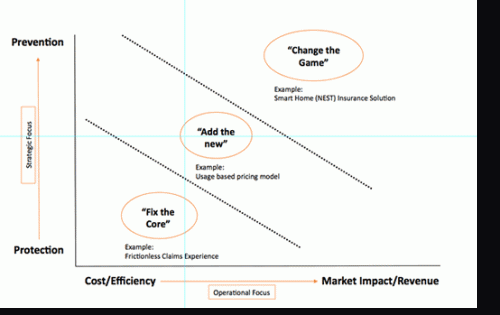Published in the American Insurance Innovation Reporter, June 2016
There are a number of converging dynamics that represent a strategic opportunity for insurance carriers to shift the basis of the relationship, the way they are perceived, and the real value they deliver.
Traditionally, insurance has been viewed by many as a necessary evil. Interactions with carriers exist at the point of purchase and possibly at a point of claim, with often a lengthy gap between those two touchpoints. The Insurance Information Institute estimates that only 3.7 percent of property and 6 percent of collision policyholders file a claim in any given year. That lack of exposure, combined with the perception that a significant percentage of consumers (21 percent*) hold the view that the products and services of carriers are largely the same, tends to drive both the buyer and seller toward “value for the money” as the underlying basis of the relationship. So, it’s no surprise to hear the repeated mantra of “15 minutes could save you 15 percent.” However, there are a number of converging dynamics that represent a strategic opportunity for insurance carriers to shift the basis of the relationship, the way they are perceived, and the real value they deliver as their next generation of prospective customers demand more personalized products and services and more continuous and meaningful dialogue with their providers.
It is also encouraging to find that there is an opportunity to develop the emotional connection that shapes a richer, more meaningful relationship. Capgemini’s World Insurance Report 2016 underscores the importance of communication and interaction, noting that Gen Y customers have higher expectations and are more easily dissatisfied, with 33.9 percent reporting positive experiences with insurers compared with 55.4 percent of older customers. This audience has a lower tolerance for long periods of inactivity and inconvenience and expect more value-add from their insurer.
In what has until recently been a fairly staid market, carrier success has been driven by a combination of effective risk management, efficient policy administration and responsive claims servicing. Up until now the insurance claim has often represented the all-important “moment of truth” with a policyholder. Unfortunately, there is tremendous relationship downside associated with a negative policyholder perception of the insurer’s claims handling performance, while the spoils for delivering an excellent experience have been largely limited to policy continuation.
Digital disruption: IOT as The Insurance of Things
That said, most pundits will tell you that these dynamics are about to change. The Internet of Things might as well be called the “Insurance of Things,” with a spate of new technologies (sensors, telematics, cognitive science) redefining the value exchange between the insured and the insurer. Forward-thinking insurers now see a whole new way to define the relationship, evolving from protection to prevention, and a shift from operational efficiency to market growth. The amount of data that can be gleaned from connected cars and homes will turn the emphasis from actuarial analytics as a means of defining risks, to behavioral analytics for identifying new sources of customer-perceived value (actionable advice) and revenue.
Clearly, a market does not shift in unison. A few pacesetters will emerge and begin to “change the game” by creating new markets of adjacent products and services while others will innovate in delivering new forms of value to existing customers. Industry laggards will remain preoccupied with fixing their core business.
The premise is that the insurance market will undergo major upheaval over the next 10 years that will fundamentally change the nature of the relationship between the insurer and the insured—driven by increasing digitization and changing demographics.

Extending the relationship
As more and more insurers seek to transform their business models to adjust to the inevitability of digital disruption and the impacts of IoT, they will surely also need to rethink how they orchestrate the customer experience. The good news is that the future holds out the prospect for deeper and more personalized relationships. However, it also ratchets-up the requirement for insurers to be able to quickly sense and respond to policyholders’ needs and expectations. The relatively static and linear customer journey of yesteryear will increasingly give way to a more fluid, event driven and interactive customer experience (CX).
Extending your policyholder relationship means that you have (near) real-time understanding of what is driving customer perceived performance, that you are able to trigger interactions with the right message to the right person at the right time and demonstrate empathy across the entire customer journey, all while interacting with them in the context of their personal circumstances. And, with the latest generation of CX software platforms, you will be able to deliver that empathy at scale thanks to automation.
Extend your Thinking
The next generation of insurance will be all about utilizing knowledge gleaned from the broadening array of (IoT) devices used in everyday life to configure solutions for policyholders based on the context or circumstances of the individual (wellness profile) and their usage patterns, with a corresponding shift in value from simply offering protection to prevention and ultimately, prescription. A major success factor in transitioning to this new model will be the insurers ability to contextualize both the product and the nature of the communications and engagement with their burgeoning ecosystem of technology (e.g., telematics, robotics, AI, etc.) providers and policyholders. Are you ready to extend yourself?
* Accenture, 2015 : Capturing the insurance customer of tomorrow
Paul Cole is president of inQuba North America, a customer experience management and customer engagement SaaS provider. Based in Los Angeles, Cole has led customer management strategy, technology and operations practices at Ernst & Young, Mercer and CapGemini. He can be reached at paul.cole@inquba.com.



